The conveyor belt industry stands at the threshold of a decade-long expansion trajectory that promises to reshape material handling and automated logistics technology. The market's journey from USD 4.3 billion in 2025 to USD 6.4 billion by 2035 represents substantial growth, demonstrating the accelerating adoption of advanced conveyor systems and material handling technologies across manufacturing facilities, logistics centers, and industrial operations worldwide.
The first half of the decade (2025-2030) will witness the market climbing from USD 4.3 billion to approximately USD 5.2 billion, adding USD 0.9 billion in value, which constitutes 42.9% of the total forecast growth period. This phase will be characterized by the rapid adoption of automated material handling systems, driven by increasing warehouse automation and Industry 4.0 programs worldwide. Advanced conveyor capabilities and integrated monitoring features will become standard expectations rather than premium options.
The latter half (2030-2035) will witness sustained growth from USD 5.2 billion to USD 6.4 billion, representing an addition of USD 1.2 billion or 57.1% of the decade's expansion. This period will be defined by mass market penetration of comprehensive automated handling platforms, integration with warehouse management systems, and seamless compatibility with existing logistics infrastructure. The market trajectory signals fundamental shifts in how industrial operators approach material handling and logistics, with participants positioned to benefit from sustained demand across multiple application segments.
Processing operations reveal significant coordination difficulties between research and development teams pursuing enhanced wear resistance characteristics and manufacturing departments optimizing production processes for cost efficiency. R&D personnel develop advanced rubber formulations incorporating specialized additives to improve belt durability and operational performance, while manufacturing teams require standardized compound specifications for automated mixing and vulcanization processes. Operations managers navigate these competing priorities against supply chain constraints when chemical ingredient availability affects production scheduling during peak demand periods.
Manufacturing constraints in food-grade conveyor operations demonstrate cross-functional coordination difficulties between materials engineering teams developing FDA-compliant rubber compounds and quality control departments ensuring migration testing compliance. Materials engineers optimize compound formulations to meet food contact material requirements while maintaining necessary physical properties for conveyor applications, while quality teams enforce testing protocols that may require extended validation periods. These competing requirements create operational bottlenecks when food industry customers demand rapid delivery schedules that conflict with comprehensive testing timelines.
Supply chain coordination challenges emerge from geographic dispersion between specialized rubber compound suppliers and belt manufacturing facilities serving regional markets. Synthetic rubber production concentrates in petrochemical regions with established polymer processing capabilities, while fabric reinforcement manufacturing locates near textile production centers with weaving expertise. Integration coordination between these dispersed suppliers requires sophisticated quality management systems when material property variations affect belt performance characteristics during diverse operational conditions.
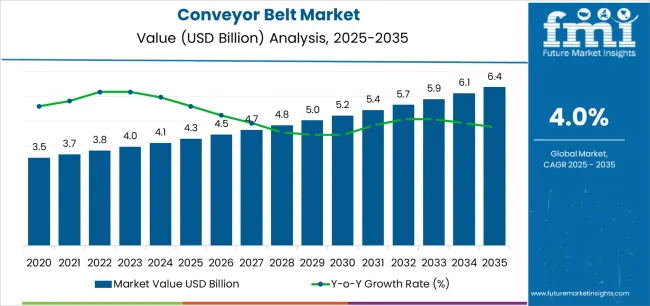
The Conveyor Belt market demonstrates distinct growth phases with varying market characteristics and competitive dynamics. Between 2025 and 2030, the market progresses through its automation adoption phase, expanding from USD 4.3 billion to USD 5.2 billion with steady annual increments averaging 3.9% growth. This period showcases the transition from basic conveyor systems to advanced automated platforms with enhanced material handling capabilities and integrated workflow systems becoming mainstream features.
The 2025-2030 phase adds USD 0.9 billion to market value, representing 42.9% of total decade expansion. Market maturation factors include standardization of automated handling protocols, declining manufacturing costs for conveyor systems, and increasing industrial awareness of conveyor benefits, reaching 88-92% efficiency in material handling applications. Competitive landscape evolution during this period features established material handling companies like Continental AG and Bridgestone expanding their conveyor portfolios while new entrants focus on specialized conveyor algorithms and enhanced integration capabilities.
From 2030 to 2035, market dynamics shift toward advanced integration and multi-platform deployment, with growth accelerating from USD 5.2 billion to USD 6.4 billion, adding USD 1.2 billion or 57.1% of total expansion. This phase transition logic centers on comprehensive handling platforms, integration with warehouse management systems, and deployment across diverse industrial specialties, becoming standard rather than specialized applications. The competitive environment matures with focus shifting from basic conveyor capability to comprehensive industrial logistics ecosystems and integration with automated monitoring and fleet management platforms.
| Metric | Value |
|---|---|
| Market Value (2025) | USD 4.3 billion |
| Market Forecast (2035) | USD 6.4 billion |
| Growth Rate | 4.0% CAGR |
| Leading Type | Roller |
| Primary End User | Industrial |
The market demonstrates strong fundamentals with Roller conveyor systems capturing a dominant share through advanced material handling features and cost-effective implementation capabilities. Industrial applications drive primary demand, supported by increasing operator spending on automation tools and handling enhancement systems. Geographic expansion remains concentrated in developed markets with established manufacturing infrastructure, while emerging economies show accelerating adoption rates driven by industrial modernization and rising automation budgets.
Market expansion rests on three fundamental shifts driving adoption across the industrial and logistics sectors. First, operational efficiency demand creates compelling operational advantages through automated conveyor systems that provide consistent material handling without labor dependency risks, enabling industrial operators to maintain throughput while achieving operational superiority and reducing labor costs. Second, warehouse automation programs accelerate as logistics authorities worldwide seek advanced automated systems that complement traditional handling methods, enabling precise material movement and monitoring applications that align with operational standards and efficiency requirements. Third, industrial infrastructure enhancement drives adoption from manufacturing operators and logistics companies requiring effective handling tools that minimize operational errors while maintaining material flow quality during complex production procedures and distribution planning.
However, growth faces headwinds from capital investment challenges that vary across operators regarding the deployment of automated conveyor systems and infrastructure budget protocols, which may limit operational flexibility in certain industrial environments. Technical limitations also persist regarding system adaptability and integration complexity that may reduce system performance with legacy equipment or non-standardized facility formats that limit handling capabilities.
The conveyor belt market represents a transformative growth opportunity, expanding from USD 4.3 billion in 2025 to USD 6.4 billion by 2035 at a 4.0% CAGR. As industrial facilities worldwide prioritize operational efficiency, material handling automation, and logistics management, automated conveyor systems have evolved from optional equipment to mission-critical infrastructure, enabling consistent material flow, reducing labor costs, and supporting operational excellence across manufacturing, warehousing, and distribution applications.
The convergence of industrial automation mandates, increasing e-commerce fulfillment requirements, material handling technology maturation, and regulatory acceptance of automated systems creates unprecedented adoption momentum. Advanced conveyor solutions offering superior efficiency, seamless facility integration, and operational compliance will capture premium market positioning, while geographic expansion into emerging industrial markets and scalable system deployment will drive volume leadership. Government industrial modernization programs and logistics automation standardization provide structural support.
Primary Classification: The market segments by type into Roller, Floor, Overhead, Pallet, and Crescent categories, representing the evolution from basic conveyor solutions to specialized automated systems for comprehensive material handling coverage.
Secondary Breakdown: Belt type segmentation divides the market into Lightweight, Medium-weight, and Heavy-weight sectors, reflecting distinct requirements for e-commerce fulfillment, general manufacturing, and heavy industrial operations.
Tertiary Classification: Material segmentation encompasses Polymers and Metals categories, while Installation classification includes Stationary and Portable systems, reflecting operational deployment preferences and facility requirements.
Application Classification: End-user segmentation divides the market into Industrial, Food & Beverage, Retail, Automotive, Airport, and Poultry & Dairy sectors, reflecting distinct requirements for manufacturing, food processing, logistics operations, and specialized handling applications.
Regional Classification: Geographic distribution covers Asia Pacific, North America, Europe, Latin America, and the Middle East & Africa, with developed markets leading adoption while emerging economies show accelerating growth patterns driven by industrial modernization programs.
The segmentation structure reveals technology progression from traditional fixed conveyor systems toward integrated automated platforms with enhanced flexibility and monitoring capabilities, while application diversity spans from industrial handling to comprehensive logistics solutions requiring precise automated assistance.
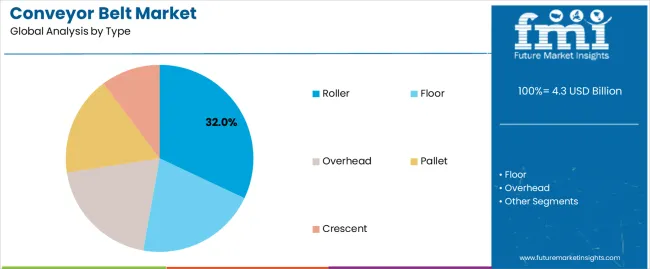
Market Position: Roller conveyor systems command the leading position in the Conveyor Belt market with approximately 32% market share through advanced material handling features, including high throughput capacity, consistent performance, and comprehensive handling capabilities that enable industrial operators to deploy automated conveyors across diverse facility environments without significant operational modifications.
Value Drivers: The segment benefits from industrial operator preference for reliable conveyor systems that provide consistent material movement without requiring extensive specialized infrastructure or complex maintenance protocols. Roller system design features enable deployment in manufacturing facilities, warehouses, and distribution centers where material flow consistency and throughput represent critical operational requirements.
Competitive Advantages: Roller systems differentiate through established handling efficiency, proven throughput capabilities, and integration with existing facility workflows that enhance operational effectiveness while maintaining cost-effective profiles suitable for industrial operators of all sizes.
Key market characteristics:
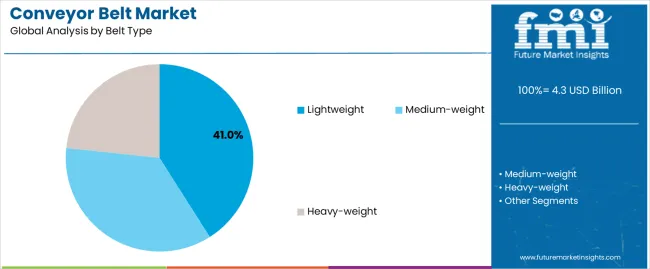
Market Context: Lightweight belt conveyors dominate the Conveyor Belt market with approximately 41% market share due to widespread adoption in e-commerce fulfillment centers, food processing facilities, and retail distribution operations requiring high-speed material handling with minimal product damage and maximum operational efficiency.
Appeal Factors: Lightweight conveyor customers prioritize system speed, energy efficiency, and integration with existing logistics infrastructure that enables coordinated material handling across multiple facility zones and operational processes. The segment benefits from substantial e-commerce growth and warehouse automation programs that emphasize lightweight conveyor acquisition for improved throughput and operational efficiency.
Growth Drivers: E-commerce fulfillment modernization programs incorporate lightweight conveyor systems as standard equipment for package sorting and distribution applications. Meanwhile, increasing operational efficiency standards are driving demand for handling capabilities that maintain speed requirements and minimize energy consumption.
Market Challenges: Load capacity limitations and durability concerns may restrict system deployment in heavy industrial environments or high-load operational scenarios.
Belt type dynamics include:
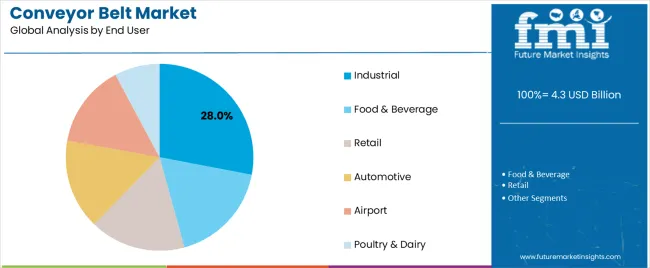
Market Context: Industrial applications dominate the Conveyor Belt market with approximately 28% market share due to widespread adoption of automated material handling systems and increasing focus on manufacturing efficiency, production optimization, and operational cost reduction applications that optimize material flow while maintaining handling effectiveness.
Appeal Factors: Industrial customers prioritize system reliability, handling capacity, and integration with existing manufacturing infrastructure that enables coordinated material movement across multiple production zones and assembly processes. The segment benefits from substantial industrial modernization budgets and automation programs that emphasize conveyor acquisition for improved operational efficiency and labor cost reduction.
Growth Drivers: Industrial modernization programs incorporate automated conveyor systems as standard equipment for production support and material handling applications. Meanwhile, increasing operational efficiency standards are driving demand for handling capabilities that maintain throughput requirements and minimize production disruptions.
Market Challenges: Capital investment constraints and integration complexity may limit system deployment in certain industrial environments or operational scenarios with legacy equipment compatibility issues.
End-user dynamics include:
Growth Accelerators: Industrial automation drives primary adoption as conveyor systems provide material handling capabilities that enable consistent operational flow without labor dependency risks, supporting production decision-making and efficiency missions that require precise logistics management. The demand for warehouse modernization accelerates market expansion as logistics operators seek effective handling enhancement tools that minimize operational errors while maintaining material flow effectiveness during complex distribution procedures and fulfillment scenarios. E-commerce spending increases worldwide, creating sustained demand for automated conveyor systems that complement traditional material handling equipment and provide operational flexibility in complex logistics environments.
Growth Inhibitors: Capital investment challenges vary across operators regarding the deployment of automated conveyor systems and budget allocation protocols, which may limit operational flexibility and market penetration in regions with constrained industrial budgets. Technical performance limitations persist regarding system adaptability and integration complexity that may reduce effectiveness with legacy facility equipment, non-standardized building layouts, or complex operational workflows that limit handling capabilities. Market fragmentation across multiple industrial standards and operational requirements creates compatibility concerns between different conveyor system providers and existing material handling infrastructure.
Market Evolution Patterns: Adoption accelerates in e-commerce fulfillment and manufacturing sectors where operational efficiency justifies system costs, with geographic concentration in developed markets transitioning toward mainstream adoption in emerging economies driven by industrial modernization and logistics infrastructure development. Technology development focuses on enhanced handling efficiency, improved automation capabilities, and compatibility with diverse facility systems that optimize material flow and operational effectiveness. The market could face disruption if alternative handling technologies or budget restrictions significantly limit automated conveyor deployment in industrial or logistics applications.
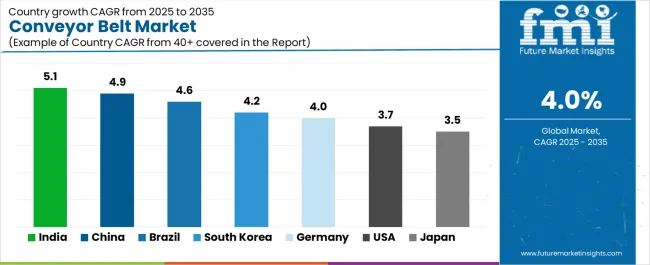
The Conveyor Belt market demonstrates varied regional dynamics with Growth Leaders including India (5.1% CAGR) and China (4.9% CAGR) driving expansion through industrial modernization and manufacturing infrastructure development. Steady Performers encompass Brazil (4.6% CAGR), South Korea (4.2% CAGR), and Germany (4.0% CAGR), benefiting from established industrial bases and advanced automation adoption. Mature Markets feature the USA (3.7% CAGR) and Japan (3.5% CAGR), where specialized industrial applications and material handling technology integration support consistent growth patterns.
| Country | CAGR (2025-2035) |
|---|---|
| India | 5.1% |
| China | 4.9% |
| Brazil | 4.6% |
| South Korea | 4.2% |
| Germany | 4.0% |
| USA | 3.7% |
| Japan | 3.5% |
Regional synthesis reveals Asia-Pacific markets leading growth through industrial modernization and manufacturing infrastructure development, while European countries maintain steady expansion supported by Industry 4.0 advancement and EU manufacturing standardization requirements. North American markets show moderate growth driven by e-commerce applications and warehouse automation trends.
India establishes high-growth market leadership through aggressive industrial modernization programs and comprehensive manufacturing infrastructure development, integrating advanced conveyor systems as standard components in warehouse automation and production facility operations. The country's 5.1% CAGR through 2035 reflects government initiatives promoting industrial automation and domestic manufacturing capabilities that mandate advanced material handling systems in facility installations. Growth concentrates in major industrial regions, including Delhi NCR, Mumbai, and Bangalore, where logistics infrastructure development showcases integrated conveyor systems that appeal to domestic operators seeking advanced handling capabilities and operational enhancement applications.
Indian manufacturers are adopting cost-effective conveyor solutions that combine domestic production advantages with advanced features, including automated control algorithms and comprehensive material handling capabilities. Distribution channels through industrial equipment suppliers and logistics service providers expand market access, while government funding for warehouse development supports adoption across diverse manufacturing and logistics segments.
Strategic Market Indicators:
In Beijing, Shanghai, and Shenzhen, manufacturing facilities and logistics operators are implementing advanced conveyor systems as standard equipment for production automation and supply chain optimization applications, driven by increasing industrial spending and smart factory programs that emphasize the use of automated material handling capabilities. The market is projected to demonstrate a 4.9% CAGR through 2035, supported by government industrial initiatives and manufacturing infrastructure development programs that promote the use of advanced automation tools for production operators and logistics authorities. Chinese industrial operators are adopting conveyor systems that provide superior handling capabilities and efficiency enhancement features, particularly appealing in coastal manufacturing regions where operational efficiency represents critical competitive requirements.
Market expansion benefits from growing industrial technology capabilities and smart factory rollout programs that enable domestic development of advanced conveyor systems for manufacturing and logistics applications. Technology adoption follows patterns established in intralogistics automation, where operational efficiency and throughput drive procurement decisions and system deployment. Smart factory initiatives emphasize conveyor integration with production management systems, while bulk material handling for metals and energy sectors creates sustained demand. Local belt production scale advantages support competitive positioning in domestic and export markets.
Market Intelligence Brief:
Brazil's market expansion benefits from diverse industrial demand, including mining operations in Minas Gerais and São Paulo manufacturing clusters, logistics infrastructure upgrades, and agricultural processing programs that increasingly incorporate automated conveyor solutions for material handling applications. The country maintains a 4.6% CAGR through 2035, driven by rising industrial awareness and increasing adoption of conveyor benefits, including superior handling capabilities and reduced operational costs.
Market dynamics focus on heavy-duty conveyor solutions that balance robust performance with affordability considerations important to Brazilian industrial operators. Growing mining sector infrastructure creates sustained demand for bulk material handling systems in iron ore and bauxite operations, while food and agri-processing automation drives conveyor adoption. Port logistics modernization programs support coastal distribution facility upgrades requiring efficient material movement systems.
Strategic Market Considerations:
South Korea's market expansion emphasizes high-technology conveyor applications, including electronics manufacturing clean-room systems, automotive production integration, and space-constrained modular installations that leverage advanced automation and precision control capabilities. The country is projected to show a 4.2% CAGR through 2035, driven by manufacturing modernization and industrial automation programs that emphasize advanced material handling systems. Korean industrial operators prioritize operational precision with conveyor systems delivering consistent handling performance through advanced control algorithms and facility integration capabilities.
Technology deployment channels include major industrial equipment contractors, specialized automation system suppliers, and manufacturing technology programs that support professional installation for complex production applications. Electronics sector demand for lightweight, clean-room compatible conveyor systems drives premium segment growth, while automotive industry robotics integration creates sophisticated handling requirements. Space-efficient modular conveyor designs address facility constraints in high-density industrial zones.
Performance Metrics:
Germany's advanced industrial technology market demonstrates sophisticated conveyor deployment with documented material handling effectiveness in manufacturing facilities and logistics centers through integration with existing production systems and industrial infrastructure. The country leverages engineering expertise in industrial automation and manufacturing systems integration to maintain a 4.0% CAGR through 2035. Industrial facilities, including those in Munich, Stuttgart, and Hamburg regions, showcase premium installations where conveyor systems integrate with comprehensive production management platforms and Industry 4.0 applications to optimize material flow and operational workflow effectiveness.
German industrial technology providers prioritize system reliability and EU regulatory compliance in conveyor development, creating demand for premium systems with advanced features, including predictive maintenance and integration with European manufacturing standards. The market benefits from established industrial infrastructure and willingness to invest in advanced automation technologies that provide long-term operational benefits and compliance with industrial regulations. Industry 4.0 retrofit programs drive conveyor modernization in existing facilities, while automotive and machinery sectors require precision handling capabilities. Food processing operations emphasize hygiene-compliant belt systems meeting stringent EU food safety regulations.
Market Intelligence Brief:
The USA market emphasizes advanced conveyor features, including high-speed sorting algorithms and integration with comprehensive warehouse management systems that manage inventory control, order fulfillment, and distribution support applications through unified logistics platforms. The country is projected to show a 3.7% CAGR through 2035, driven by e-commerce expansion and warehouse automation programs supporting logistics facility upgrades and industrial modernization initiatives. American logistics operators prioritize operational throughput with conveyor systems delivering consistent material handling through advanced automation algorithms and operational efficiency capabilities.
Technology deployment channels include major material handling equipment contractors, specialized logistics system suppliers, and warehouse automation programs that support professional installation for complex distribution applications. High-throughput e-commerce distribution centers drive primary conveyor demand, particularly in regions with major fulfillment operations. Airport baggage handling modernization programs create specialized conveyor requirements, while labor-saving automation initiatives across manufacturing and logistics sectors support sustained market growth.
Performance Metrics:
Japan demonstrates steady market development with a 3.5% CAGR through 2035, distinguished by industrial operators' preference for high-quality conveyor systems that integrate seamlessly with existing production equipment and provide reliable long-term operation in specialized manufacturing applications. The market prioritizes advanced features, including precision control algorithms, maintenance validation, and integration with comprehensive production platforms that reflect Japanese industrial expectations for technological sophistication and operational excellence. Space-efficient conveyor designs address facility constraints in high-density industrial environments, while aging workforce demographics drive automation adoption. Electronics and food & beverage sectors emphasize hygiene-compliant systems, and retail applications include specialized kaiten (rotating) conveyor installations.
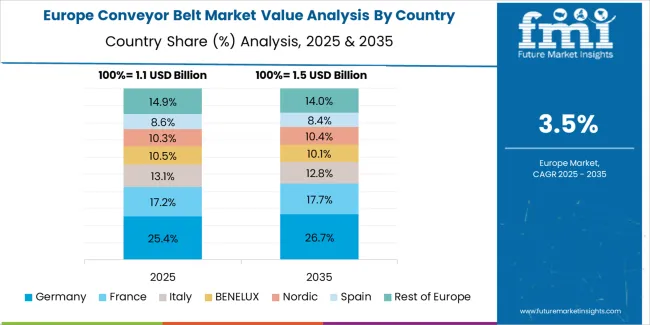
The Conveyor Belt market in Europe is projected to grow from USD 1.1 billion in 2025 to USD 1.6 billion by 2035, registering a CAGR of 3.8% over the forecast period. Germany is expected to maintain leadership with a 29.0% market share in 2025, easing to 28.6% by 2035, supported by advanced automotive, machinery, and hygienic food and beverage processing operations.
The United Kingdom follows with an 18.9% share in 2025, edging to 19.1% by 2035, driven by warehouse automation programs and strict food safety standards. France holds a 16.4% share in 2025, moving to 16.6% by 2035 through industrial modernization and packaging facility upgrades. Italy accounts for a 13.1% share in 2025, rising to 13.3% by 2035 with machinery manufacturing and ceramics bulk material handling expansion. Spain stands at 9.3% in 2025, reaching 9.5% by 2035 as logistics hub infrastructure expands. The Netherlands maintains a 4.5% share in 2025, growing to 4.6% by 2035 through food logistics operations and export distribution flows. The Rest of Europe region, including Nordic countries, Central and Eastern Europe, BENELUX beyond the Netherlands, Switzerland, and Austria, holds 8.8% in 2025, moderating to 8.3% by 2035 amid mixed market maturity levels and varying modernization cycles across diverse economies.
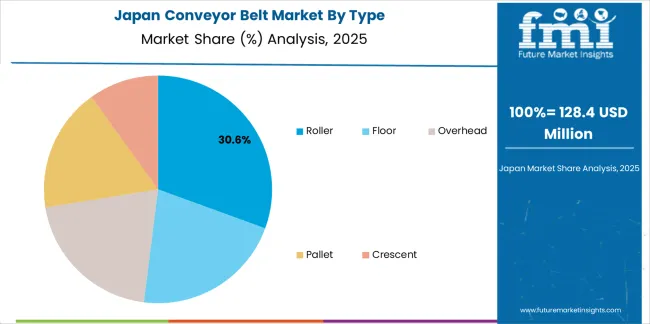
In Japan, the Conveyor Belt market prioritizes Roller conveyor systems, which capture the dominant share through advanced precision control capabilities, seamless integration with existing production equipment, and superior reliability standards that align with Japanese industrial expectations for technological sophistication and operational excellence. Japanese manufacturers emphasize system durability and space-efficient designs that address facility constraints in high-density industrial environments, creating demand for conveyor solutions that provide long-term operational validation and minimal maintenance requirements without disrupting established production workflows. The market demonstrates steady growth at 3.5% CAGR through 2035, supported by aging workforce demographics driving automation adoption and specialized applications in electronics and food & beverage sectors requiring hygiene-compliant systems with precision handling characteristics. Lightweight belt systems maintain secondary positioning primarily in retail applications, including specialized kaiten (rotating) conveyor installations and space-constrained operations where compact design represents critical selection criteria.
Market Characteristics:
In South Korea, the market structure favors international technology companies, including Continental AG, Bridgestone, and Habasit, which maintain dominant positions through comprehensive conveyor portfolios and established distribution networks supporting both electronics manufacturing and automotive production facilities. These providers offer integrated solutions combining high-technology conveyor applications with professional installation services and ongoing technical support that appeal to Korean operators seeking advanced material handling systems with clean-room compatibility and precision control capabilities. Local industrial equipment contractors capture moderate market share by providing specialized automation system integration and competitive installation services for complex production applications, while domestic manufacturers focus on modular conveyor designs and cost-effective solutions tailored for Korean high-density industrial zones. The market projects 4.2% CAGR through 2035, driven by manufacturing modernization programs and industrial automation initiatives that emphasize advanced material handling systems for electronics and automotive sectors.
Channel Insights:

The Conveyor Belt Market is expanding steadily as industries such as manufacturing, mining, automotive, and logistics increasingly rely on conveyor systems for efficient material handling and automation. The demand for durable, energy-efficient, and customized conveyor belts is driving the market's growth, particularly with the rise of e-commerce, automation technologies, and the push for sustainability. Innovations in material technology, such as lightweight and heat-resistant belts, are improving operational efficiency and reducing maintenance costs, while the demand for eco-friendly solutions continues to rise.
Continental AG, Bridgestone, and Yokohama Rubber are major players in the global conveyor belt market, offering a broad range of high-performance belts for various industrial applications. Their products are known for durability, reliability, and energy efficiency, with advancements in fabric technology that meet the needs of sectors like mining, logistics, and automotive manufacturing. Fenner (Michelin) and Habasit are also key contributors, providing solutions that cater to both standard and specialized conveyor belt applications, particularly in the food processing and pharmaceuticals industries.
Regional and niche players like Forbo Movement Systems, Ammeraal Beltech (AMMEGA), and Intralox are focusing on specific sectors, such as food handling and high-tech industrial applications, offering modular conveyor systems and tailored solutions for automated production lines. Meanwhile, Semperit and Zhejiang Double Arrow are making significant strides in the Asian market, where demand for conveyor belts in logistics, manufacturing, and mining continues to rise. These companies are positioning themselves as leaders in providing customized solutions that improve operational efficiency and reduce downtime across industries.
| Item | Value |
|---|---|
| Quantitative Units | USD 4.3 billion |
| Type | Roller, Floor, Overhead, Pallet, Crescent |
| Belt Type | Lightweight, Medium-weight, Heavy-weight |
| Material | Polymers, Metals |
| Installation | Stationary, Portable |
| End User | Industrial, Food & Beverage, Retail, Automotive, Airport, Poultry & Dairy |
| Regions Covered | Asia Pacific, North America, Europe, Latin America, Middle East & Africa |
| Countries Covered | India, China, Brazil, South Korea, Germany, the USA, Japan, and 25+ additional countries |
| Key Companies Profiled | Continental AG, Bridgestone, Yokohama Rubber, Fenner (Michelin), Habasit, Forbo Movement Systems, Ammeraal Beltech (AMMEGA), Intralox, Semperit, Zhejiang Double Arrow |
| Additional Attributes | Dollar sales by type, belt type, material, installation, and end-user categories, regional adoption trends across Asia Pacific, North America, and Europe, competitive landscape with material handling providers and conveyor specialists, industrial operator preferences for handling efficiency and system reliability, integration with warehouse management systems and logistics workflows, innovations in belt materials and automated handling, and development of advanced solutions with enhanced throughput and monitoring capabilities. |
The global conveyor belt market is estimated to be valued at USD 4.3 billion in 2025.
The market size for the conveyor belt market is projected to reach USD 6.4 billion by 2035.
The conveyor belt market is expected to grow at a 4.0% CAGR between 2025 and 2035.
The key product types in conveyor belt market are roller, floor, overhead, pallet and crescent.
In terms of belt type, lightweight segment to command 41.0% share in the conveyor belt market in 2025.






Our Research Products

The "Full Research Suite" delivers actionable market intel, deep dives on markets or technologies, so clients act faster, cut risk, and unlock growth.

The Leaderboard benchmarks and ranks top vendors, classifying them as Established Leaders, Leading Challengers, or Disruptors & Challengers.

Locates where complements amplify value and substitutes erode it, forecasting net impact by horizon

We deliver granular, decision-grade intel: market sizing, 5-year forecasts, pricing, adoption, usage, revenue, and operational KPIs—plus competitor tracking, regulation, and value chains—across 60 countries broadly.

Spot the shifts before they hit your P&L. We track inflection points, adoption curves, pricing moves, and ecosystem plays to show where demand is heading, why it is changing, and what to do next across high-growth markets and disruptive tech

Real-time reads of user behavior. We track shifting priorities, perceptions of today’s and next-gen services, and provider experience, then pace how fast tech moves from trial to adoption, blending buyer, consumer, and channel inputs with social signals (#WhySwitch, #UX).

Partner with our analyst team to build a custom report designed around your business priorities. From analysing market trends to assessing competitors or crafting bespoke datasets, we tailor insights to your needs.
Supplier Intelligence
Discovery & Profiling
Capacity & Footprint
Performance & Risk
Compliance & Governance
Commercial Readiness
Who Supplies Whom
Scorecards & Shortlists
Playbooks & Docs
Category Intelligence
Definition & Scope
Demand & Use Cases
Cost Drivers
Market Structure
Supply Chain Map
Trade & Policy
Operating Norms
Deliverables
Buyer Intelligence
Account Basics
Spend & Scope
Procurement Model
Vendor Requirements
Terms & Policies
Entry Strategy
Pain Points & Triggers
Outputs
Pricing Analysis
Benchmarks
Trends
Should-Cost
Indexation
Landed Cost
Commercial Terms
Deliverables
Brand Analysis
Positioning & Value Prop
Share & Presence
Customer Evidence
Go-to-Market
Digital & Reputation
Compliance & Trust
KPIs & Gaps
Outputs
Full Research Suite comprises of:
Market outlook & trends analysis
Interviews & case studies
Strategic recommendations
Vendor profiles & capabilities analysis
5-year forecasts
8 regions and 60+ country-level data splits
Market segment data splits
12 months of continuous data updates
DELIVERED AS:
PDF EXCEL ONLINE
Conveyor Belt Tracking Devices Market Size and Share Forecast Outlook 2025 to 2035
Conveyor Belt Materials Market
Conveyors and Belt Loaders Market Growth - Trends & Forecast 2025 to 2035
Rubber Conveyor Belt Market Size, Growth, and Forecast 2025 to 2035
Demand for Conveyor Belts in EU Size and Share Forecast Outlook 2025 to 2035
Middle East Conveyor Belts Market - Growth & Demand 2025 to 2035
Agricultural Food Grade Rubber Conveyor Belt Market Growth - Trends & Forecast 2025 to 2035
Belt Trainers Market Size and Share Forecast Outlook 2025 to 2035
Belt File Sander Market Size and Share Forecast Outlook 2025 to 2035
Conveyor System Market Size and Share Forecast Outlook 2025 to 2035
Belt Feeders Market Size and Share Forecast Outlook 2025 to 2035
Conveyor Drives Market Analysis - Size, Share, and Forecast Outlook 2025 to 2035
Conveyor Dishwasher Market Size and Share Forecast Outlook 2025 to 2035
Conveyor Maintenance Industry Analysis in Australia - Size, Share, and Forecast Outlook 2025 to 2035
Conveyor Dryer Market Growth, Trends & Forecast 2025 to 2035
Conveyor Ovens & Impinger Ovens Market
UV Conveyor Systems Market
Seatbelt Polyester Yarn Market Size and Share Forecast Outlook 2025 to 2035
Pack Conveyors Market Size and Share Forecast Outlook 2025 to 2035
Screw Conveyor Market Size and Share Forecast Outlook 2025 to 2035

Thank you!
You will receive an email from our Business Development Manager. Please be sure to check your SPAM/JUNK folder too.
Chat With
MaRIA